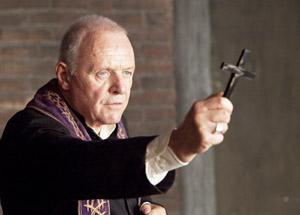
By Barb Arland-Fye
DAVENPORT — Wanting to review “The Rite,” a new movie about the training of an exorcist, I asked the Davenport Diocese’s own exorcist, Msgr. Marvin Mottet, to join me.
The movie debuted Jan. 28 — two months after the U.S. bishops sponsored a conference for clergy on the Liturgical and Pastoral Practice of Exorcism in response to growing interest in the subject and a shortage of trained exorcists.
Prior to the conference, about 14 official exorcists were listed in the U.S., said Msgr. Mottet, who has been the Davenport Diocese’s exorcist since 1993. He was curious to see how the new movie depicted the rite and the ministers of that rite, who are ordained priests. I wanted Msgr. Mottet alongside of me at the movie for his expertise and, honestly, to alleviate the fear factor.
But The Rite wasn’t horrifying in comparison to conventional horror movies. It was intense in its portrayal of human suffering and the prayerful appeal for God’s mercy. In brief, the movie tells the story of a seminarian named Michael who submits his resignation after his ordination as a transitional deacon. The seminary’s rector “persuades” Michael to reconsider his decision and travel to Rome to take a course on exorcism. Otherwise, he’ll have to repay his tuition. During his exorcism studies, Michael is assigned to visit a respected, aging exorcist named Father Lucas. (Both characters are based on real exorcists.)
All of us who have been baptized in the Roman Catholic Church have received the rite of exorcism in its simple form. In a full exorcism, the exorcist expels demons from an individual or liberates that individual from demonic possession through the spiritual authority Jesus has entrusted in his Church, according to the Catechism of the Catholic Church.
While full exorcism occurs rarely, Bishop Thomas Paprocki of Springfield, Ill., told Catholic News Service in November, the movie’s exorcist seems to be immersed in them! Michael remains skeptical, questioning whether psychosis rather than demonic possession is the source of torment for the individuals Fr. Lucas is ministering to. It’s not until the end of the movie, when Fr. Lucas becomes possessed, that Michael finds his faith and exorcises his mentor’s demons.
That’s just Hollywood hype, says Msgr. Mottet. “I’ve never heard of an exorcist being possessed, as the movie portrays, but sometimes an exorcist is attacked by Satan.” A team of at least several individuals accompany an exorcist — to provide prayer, additional discernment and physical protection. Msgr. Mottet said he’s had someone break up a chair during an exorcism.
Msgr. Mottet cited other factual errors in the movie, while noting that it portrayed the rite of exorcism and its ministers in a respectful manner. The monsignor pointed out that only an ordained priest, with permission from his bishop, can perform the rite of exorcism in the Catholic Church. Michael the seminarian was out of his league, both in terms of performing the rite and in having no back-up, other than an attractive female journalist.
And while 80-year-old Msgr. Mottet had trouble hearing some of the movie’s dialogue, the frequent yelling was an error he didn’t miss. “You don’t yell. You shouldn’t. The power is not in your voice, the power is in the name of Jesus.” The ritual’s prayers invoke the saints and angels of paradise, the martyrs and confessors, the army of heaven, he said.
The movie’s exorcist struggled mightily to exorcise the demons from a 16-year-old girl reportedly impregnated by her father. I asked Fr. Mottet why the demons continued to return and whether she was psychotic rather than possessed. “You certainly have to rule out any mental illness,” Msgr. Mottet said. “If there is any doubt, the exorcist is instructed to consult a psychiatrist.”
Requests for an exorcism far exceed the actual number of people possessed by a demon, Bishop Paprocki noted in the CNS article.
“In my view, many of the cases referred are less than possession and can be taken care of by ‘deliverance,’ which can be performed by trained lay people,” Msgr. Mottet said.
Among details the movie did get right concerning demonic possession, he said, were: shows of excessive strength, inexplicable knowledge, command of languages not learned, and aversion toward blessed holy water, salt, crucifixes, rosaries and the names of Jesus and the Blessed Virgin Mary.
“You can’t be possessed unless you invite Satan in,” Msgr. Mottet stressed. People who struggle with addictions or get caught up in satanic rituals or games such Ouija boards and Dungeons & Dragons can be especially vulnerable, he added.
“Many people don’t believe in the life of the Spirit or that demons exist … so we’re fighting a rear guard. That’s why there’s so much demonic activity,” Msgr. Mottet said. “I wish some Catholic group would put out a movie that is accurate and doesn’t use all of these theatrics. People are hurting; they could be healed.”
More information
“The Rite,” a movie showing in area theaters, is classified A-III (adults) by Catholic News Service because the film “contains incest and suicide themes, some gruesome imagery, incidental irreverence, a couple of uses of profanity and a few rough and crude terms.” The Motion Picture Association of America rating is PG-13.
For more information about exorcism, read the Catechism of the Catholic Church or visit the website of the U.S. Conference of Catholic Bishops at www.usccb.org.
Msgr. Marvin Mottet recommends the book: “An Exorcist Tells His Story,” by Father Gabriele Amorth.








